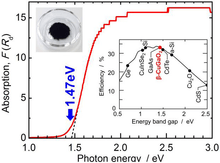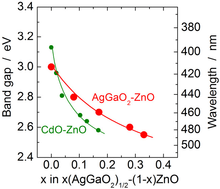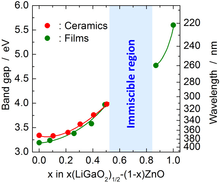I-III-VI semiconductors
I-III-VI2 semiconductors are solid semiconducting materials that contain three or more chemical elements belonging to groups I, III and VI of the periodic table. They usually involve two metals and one chalcogen. Some of these materials have a direct bandgap, Eg, of ~ 1.5 eV, which makes them efficient absorbers of sunlight and thus potential solar cell materials. A fourth element is often added to a I-III-VI2 material to tune the bandgap for maximum solar cell efficiency. A representative example is copper indium gallium selenide (CuInxGa(1–x)Se2, Eg = 1.7–1.0 eV for x = 0–1[1]), which is used in copper indium gallium selenide solar cells.

CuGaO2
CuGaO2 exists in two main polymorphs, α and β. The α form has the delafossite crystal structure and can be prepared by reacting Cu2O with Ga2O3 at high temperatures. The β form has a wurtzite-like crystal structure (space group Pna21); it is metastable, but exhibits a long-term stability at temperatures below 300 °C.[3] It can be obtained by an ion exchange of Na+ ions in a β-NaGaO2 precursor with Cu+ ions in CuCl under vacuum, to avoid the oxidation of Cu+ to Cu2+.[2]
Unlike most I-III-VI2 oxides, which are transparent, electrically insulating solids with a bandgap above 2 eV, β-CuGaO2 has a direct bandgap of 1.47 eV, which is favorable for solar cell applications. In contrast, β-AgGaO2 and β-AgAlO2 have an indirect bandgap. Undoped β-CuGaO2 is a p-type semiconductor.[2]
AgGaO2 and AgAlO2

Similarly to CuGaO2, α-AgGaO2 and α-AgAlO2 have the delafossite crystal structure while the structure of the corresponding β phases is similar to wurtzite (space group Pna2a). β-AgGaO2 is metastable and can be synthesized by ion exchange with a β-NaGaO2 precursor. The bandgaps of β-AgGaO2 and β-AgAlO2 (2.2 and 2.8 eV respectively) are indirect; they fall into the visible range and can be tuned by alloying with ZnO. For this reason, both materials are hardly suitable for solar cells, but have potential applications in photocatalysis.[2]
Contrary to LiGaO2, AgGaO2 can not be alloyed with ZnO by heating their mixture because of the Ag+ reduction to metallic silver; therefore, magnetron sputtering of AgGaO2 and ZnO targets is used instead.[2]
LiGaO2

Pure single crystals of β-LiGaO2 with a length of several inches can be grown by the Czochralski method. Their cleaved surfaces have lattice constants that match those of ZnO and GaN and are therefore suitable for epitaxial growth of thin films of those materials. β-LiGaO2 is a potential nonlinear optics material, but its direct bandgap of 5.6 eV is too wide for visible light applications. It can be reduced down to 3.2 eV by alloying β-LiGaO2 with ZnO. The bandgap tuning is discontinuous because ZnO and β-LiGaO2 do not mix but form a Zn2LiGaO4 phase when their ratio is between ca. 0.2 and 1.[2]
| Formula | a (Å) | b (Å) | c (Å) | Space group | Density (g/cm3) |
Melting point (K) |
Bandgap (eV) |
|---|---|---|---|---|---|---|---|
| α-LiGaO2[5] | 2.92 | 2.92 | 14.45 | R3m | 5.07 | m | 5.6d |
| β-LiGaO2[6] | 5.406 | 6.379 | 5.013 | Pna21 | 4.18 | m | 5.6d |
| CuAlS2 | 5.323 | 5.323 | 10.44 | I42d | 3.47 | 2500 | 2.5 |
| CuAlSe2 | 5.617 | 5.617 | 10.92 | I42d | 4.70 | 2260 | 2.67 |
| CuAlTe2 | 5.976 | 5.976 | 11.80 | I42d | 5.50 | 2550 | 0.88 |
| β-CuGaO2[3] | 5.46004(1) | 6.61013(2) | 5. 27417(1) | Pna21 | m | 1.47d | |
| CuGaS2 | 5.360 | 5.360 | 10.49 | I42d | 4.35 | 2300 | 2.38 |
| CuGaSe2 | 5.618 | 5.618 | 11.01 | I42d | 5.56 | 1970 | 0.96; 1.63 |
| CuGaTe2 | 6.013 | 6.013 | 11.93 | I42d | 5.99 | 2400 | 0.82; 1.0 |
| CuInS2 | 5.528 | 5.528 | 11.08 | I42d | 4.75 | 1400 | 1.53 |
| CuInSe2 | 5.785 | 5.785 | 11.56 | I42d | 5.77 | 1600 | 0.86; 0.92 |
| CuInTe2 | 6.179 | 6.179 | 12.365 | I42d | 6.10 | 1660 | 0.95 |
| CuTlS2 | 5.58 | 5.58 | 11.17 | I42d | 6.32 | ||
| CuTlSe2 | 5.844 | 5.844 | 11.65 | I42d | 7.11 | 900 | 1.07 |
| CuFeO2 | 3.035 | 3.035 | 17.166 | R3m | 5.52 | ||
| CuFeS2 | 5.29 | 5.29 | 10.32 | I42d | 4.088 | 1135 | 0.53 |
| CuFeSe2 | I42d | 850 | 0.16 | ||||
| CuLaS2 | 5.65 | 5.65 | 10.86 | I42d | |||
| β-AgAlO2 | m | 2.8i | |||||
| AgAlS2 | 5.707 | 5.707 | 10.28 | I42d | 3.94 | ||
| AgAlSe2 | 5.986 | 5.986 | 10.77 | I42d | 5.07 | 1220 | 0.7 |
| AgAlTe2 | 6.309 | 6.309 | 11.85 | I42d | 6.18 | 1000 | 0.56 |
| α-AgGaO2 | P63mc | 4.12d[7] | |||||
| β-AgGaO2 | Pna2a | m | 2.2i | ||||
| AgGaS2 | 5.755 | 5.755 | 10.28 | I42d | 4.72 | 1.66 | |
| AgGaSe2 | 5.985 | 5.985 | 10.90 | I42d | 5.84 | 1120 | 1.1 |
| AgGaTe2 | 6.301 | 6.301 | 11.96 | I42d | 6.05 | 990 | 1.9 |
| AgInS2 | 5.828 | 5.828 | 11.19 | I42d | 5.00 | 1.18 | |
| AgInSe2 | 6.102 | 6.102 | 11.69 | I42d | 5.81 | 1053 | 0.96; 0.52 |
| AgInTe2 | 6.42 | 6.42 | 12.59 | I42d | 6.12 | 965 | |
| AgFeS2 | 5.66 | 5.66 | 10.30 | I42d | 4.53 | 0.88 [8] |
- m stands for metastable, d for direct and i for indirect bandgap
See also
References
- ↑ Tinoco, T.; Rincón, C.; Quintero, M.; Pérez, G. S. N. (1991). "Phase Diagram and Optical Energy Gaps for CuInyGa1−ySe2 Alloys". Physica Status Solidi (a). 124 (2): 427–434. Bibcode:1991PSSAR.124..427T. doi:10.1002/pssa.2211240206.
- 1 2 3 4 5 6 7 8 Omata, T.; Nagatani, H.; Suzuki, I.; Kita, M. (2015). "Wurtzite-derived ternary I–III–O2 semiconductors". Science and Technology of Advanced Materials. 16 (2): 024902. Bibcode:2015STAdM..16b4902O. PMC 5036475
 . PMID 27877769. doi:10.1088/1468-6996/16/2/024902.
. PMID 27877769. doi:10.1088/1468-6996/16/2/024902.
- 1 2 Nagatani, H.; Suzuki, I.; Kita, M.; Tanaka, M.; Katsuya, Y.; Sakata, O.; Miyoshi, S.; Yamaguchi, S.; Omata, T. (2015). "Structural and Thermal Properties of Ternary Narrow-Gap Oxide Semiconductor; Wurtzite-Derived β-CuGaO2". Inorganic Chemistry. 54 (4): 1698–704. PMID 25651414. doi:10.1021/ic502659e.
- ↑ Haynes, William M., ed. (2011). CRC Handbook of Chemistry and Physics (92nd ed.). Boca Raton, FL: CRC Press. pp. 12.82 and 12.87. ISBN 1439855110.
- ↑ Hoppe, R. (1965) Bull. Soc. Chim. Fr., 1115–1121
- ↑ Konovalova E.A., Tomilov N.P. (1987) Russ. J. Inorg. Chem. 32, 1785–1787
- ↑ Vanaja, K. A.; Ajimsha, R. S.; Asha, A. S.; Rajeevkumar, K.; Jayaraj, M. K. (2008). "Pulsed laser deposition of p-type α-AgGaO2 thin films". Thin Solid Films. 516 (7): 1426–1430. Bibcode:2008TSF...516.1426V. doi:10.1016/j.tsf.2007.07.207.
- ↑ Sciacca, B.; Yalcin, A. O.; Garnett, E. C. (2015). "Transformation of Ag Nanowires into Semiconducting AgFeS2 Nanowires". Journal of the American Chemical Society. 137 (13): 4340–4343. doi:10.1021/jacs.5b02051.